Metro: Last Light - 12 things you need to know
The sequel to Metro 2033 promises to be one of 2013's creepiest shooters
The metro awaits
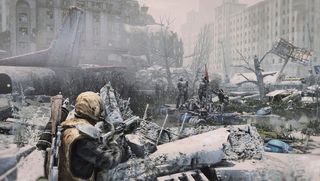
Over the past few years, plenty of first-person shooters have vied for control of the multiplayer arena. But the battle for online supremacy (which Call of Duty continues to win) has left a bit of a void when it comes to meaningful single-player shooters. While 2010's Metro 2033 was far from perfect, it remains an excellent example of the atmospheric solo experiences that shooters can achieve.
Now, its sequel--Metro: Last Light--is only a couple months away from release. This FPS won't force any half-baked multiplayer modes on you, nor will it hold you by the hand through linear corridors while your crosshairs automatically snap to the nearest target's head. Having played two hours of the game, we learned fairly quickly that the dangerous tunnels of the metro are as unkind as they are dark. Looking forward to a fresh shooter experience? Here's everything you need to know about Metro: Last Light.
Note: There are some spoilers for 2010's Metro 2033 ahead.
The world is dark and dangerous
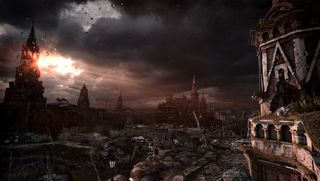
Metro: Last Light, like 2033, takes place in a post-apocalyptic Moscow, where the survivors of a devastating nuclear war have taken refuge in the city's metro tunnels. Naught remains on the surface except for the empty husk of civilization. Cars sit ruined and abandoned on destroyed highways, while half-collapsed buildings punctuate the darkened skyline. The air is deadly thanks to radiation--and even if it were breathable, mankind would have to face the mutated monstrosities that now inhabit the surface thanks to years of radiation exposure.
Things aren't much better underground. While folks can breathe without fear of dying, they have to deal with the lack of natural light and damp, cramped living conditions. Not only that, but resources--namely food and water--aren't exactly plentiful. Last Light's dark undertones and bleak representation of a ruined Earth are extremely harrowing, as is the unnerving tension that it frequently builds. Exploring long-abandoned tunnels in the metro with only your flashlight and a pistol (which, conveniently, you've just run out of ammunition for) is downright terrifying. Worst of all, there's conflict brewing, despite the fact that war was the reason humanity moved underground in the first place.
It takes place a year after Metro 2033
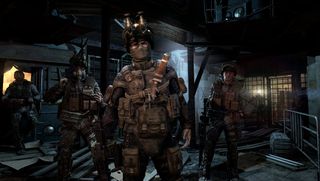
Artyom, the hero of Metro 2033, returns as Last Light's protagonist a mere year after the previous game's events. Metro 2033 spoiler: Those who finished the first game will recall that Artyom had a choice at the end to either destroy the Dark Ones--friendly psychic mutants that were misinterpreted to be hostile--or allow them to live. You see, the Dark Ones wanted to form an alliance with the survivors of the metro to build a new life on the surface of the Earth; they could provide protection in exchange for the labor required to recreate civilization, as the Dark Ones no longer had the ability to create or use technology.
So here's the thing. Last Light assumes you destroyed them. Artyom struggles with this act on a daily basis, having discovered their true intent moments after wiping them out. But rumors are floating around that a single Dark One has survived, and Artyom is tasked with finding the creature. This, of course, is no easy task, and he'll have to overcome the dangers of the metro and the Earth's surface alike if he hopes to do so.
Sign up to the 12DOVE Newsletter
Weekly digests, tales from the communities you love, and more
You'll encounter plenty of ghostly visions
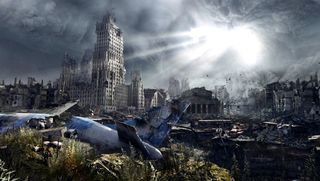
Adding to the game's creepy, dark vibe are the ghosts and imprints of long-dead humans obliterated by nuclear explosions. Occasionally you'll catch a glimpse of an apparition out of the corner of your eye--sometimes you'll hallucinate events that happened right as death rained from the skies above Moscow.
We saw one of these events ourselves during a mission that had us searching for supplies from within a downed plane on the Earth's surface. Inside, charred human bodies remained strapped to the seats they perished in. Most had been turned to ash, still sitting in place. As we moved into the cockpit, a vision flooded Artyom's mind: the pilots, and everyone on the plane, were alive. A few moments later, missiles poured from the heavens, and the initial blast of the impact stripped the plane of power. As it plummeted toward the earth, everyone was screaming, praying, crying. Then, in a flash of light, it ended. Seeing those bodies there afterward was chilling. Moments like these are sprinkled throughout the game, and they're an incredibly effective vehicle of storytelling.
Humans and monsters are eager to end you
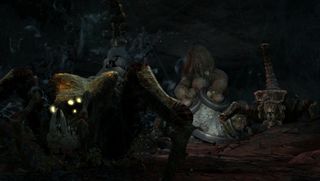
The metro is divided up into several stations, most of which have become independent city-states aligned with one of four factions: the capitalistic Rangers, the fascist neo-Nazis, the Red Line Communists, or the Knights Templar. Artyom is a member of the Rangers, and, as such, doesn't exactly get along with some of the other "extreme" groups, who would rather put a bullet in his head than let him pass through their territory. Typical enemy soldiers are fairly easy to take down (looting their corpses are a great way to replenish your limited ammo), while some of the stronger ones wear giant suits of armor. To take these hulking humans out, you'll have to expend a lot of ammo chipping away at their armor first.
But the metro tunnels are also home to monsters. We encountered the doggish Watchers, Gargoyle-esque Demons, and plenty of humanoid Nosalises during our demo--but we also faced new monsters referred to as "Shrimps." These mostly docile mutants feed on human corpses, but rarely attack living beings unless provoked. Let's just say we did a bit of provoking, and it didn't end well for us.
It doesn't play like a corridor shooter (even though a lot of it takes place in... corridors)
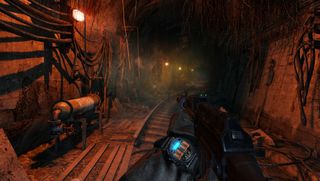
Where most shooters are all about crazy explosions and punching your eyeballs with a barrage of over-the-top setpiece moments, Metro: Last Light--like its predecessor--is about building atmosphere and immersion. There are no objective markers directing you where to go, or how to overcome an obstacle. It's up to you to figure things out.
There are also plenty of hidden areas rife with extra ammunition, weapons, or narrative context for those willing to do a bit of searching. It's not an open world game by any means--there's plenty of linear segments and scripting to be found--but the illusion of openness is adequately alluring, especially during the times you'll be tasked with exploring the Earth's surface. More importantly, Last Light gives you the option to play as you wish. Sneaking around in the dark of the tunnels is a totally viable path, but if you'd rather shoot everything that moves, go for it. Just know that you're in for a hell of a challenge.
The guns-blazing approach can be a tough one to pull off...
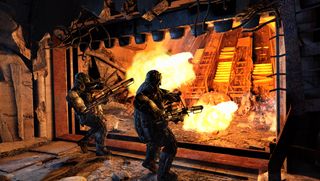
Case in point, we entered a large room Rambo-style early on in our demo, only to discover the hard way that it was actually a Communist checkpoint. We caught some guards by surprise and took them down with ease, but once their buddies figured out what was going on, they began firing en masse. The cement barricade we were hiding behind began to dissolve under the force of incoming bullets. That's when things got a bit tricky.
First, we started to run low on ammo--and when we'd leave the safety of cover to retrieve some from a corpse, there was no guarantee we'd survive. The second issue was that we ran into a few of those heavily armored enemies mentioned previously, who required a lot of bullets to kill. Finally, we noticed that one enemy headed straight for a gas valve--then donned a gas mask and turned the thing on, causing the room to fill with toxic air. Thankfully we had a gas mask of our own (and we'll talk more about the importance of said gas mask in a bit), but alas, in the end we died horribly anyway.
...or you can shoot out the lights to your advantage
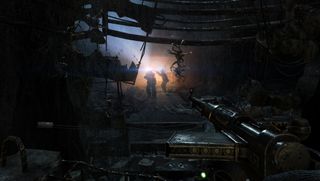
After restarting that same segment, we tried a stealth approach. Thankfully, the metro tunnels are naturally dark, and it's pretty common for the make-shift light bulbs and other light sources that...light them...to fail. A small fire nearby was boiling a pot of water. After patrolling guards walked away from it, we shot the suspended bucket, which doused the flames below. An LED light on our wristwatch indicated that we were now totally hidden in the dark. Thanks, video game devices!
Using our silenced pistol, we shot out some nearby light bulbs and turned off an electric switchboard, turning the room pitch black. The guards, realizing something was up, turned on their headlamps and began to search for us. Once they separated, we snuck up behind them and were presented with a choice: kill or incapacitate. Why would you knock enemies out instead of killing them? Because how you play will dictate which ending you'll receive. We decided to take them out with a knife to the back--though a patrolling dude found a corpse, which launched the guns-blazing scenario from earlier into full swing. Thankfully we survived the second time.
Guns don't feel underpowered anymore

A common complaint with Metro 2033 was that its weapons felt too underpowered, as you'd often spend an entire clip of ammo trying to take down a single opponent. That wasn't the case in Last Light (well, so long as we weren't facing a heavily armored foe). The few guns we had access to sounded pretty decent and had adequate stopping power.
The great thing here is that every single gun you pick up has an entirely different playstyle. There's your standard revolver, assault rifle, and even a double-barreled sawed-off shotgun. But then there are the makeshift weapons that were constructed from odds and ends lying around the metro. A makeshift shotgun-like weapon, for example, had a rotating cylinder of shells, which allowed us to fire several rounds in succession without reloading. Plenty of inventive weapons can be found throughout the metro, and you can now carry up to three of them at once instead of two. None of them felt like a reskinned version of another.
Huge improvements have been made to enemy AI since Metro 2033

Another issue many had with Metro 2033 was that enemies seemed omniscient of your location. If one happened to see you while you were sneaking around all stealth-like, suddenly every bad guy knew where you were, and would shoot at you with pinpoint accuracy, even if the room was completely dark.
Now enemies will search you out, even if their pals are blasting away in your general direction. We took advantage of this after being spotted by a lone enemy. As he cried out to his comrades, we rearranged his rib cage with a shotgun blast, then crept back into the shadows while they hunted for our location. Fortunately for us, we found them first.
The gas mask is your friend
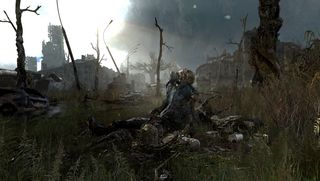
Your gas mask will be the most trustworthy companion you'll have in Last Light. It'll need to be worn in cavernous areas of the metro that emanate poisonous fumes, as well as any time you head above ground during certain points in the story. Just keep your eye out for additional filters--you'll need to replace them every five minutes (tracked by a timer on your wristwatch, which is now displayed in a digital format instead of analog) or you'll succumb to the radioactive air.
As in Metro 2033, the gas mask adds a surprising layer of immersion to the whole experience. As your filter nears its end, Artyom's breathing gets heavier and heavier while the mask's goggles are obscured by the moisture of his exhalation. Though failing to replace the filter means death, it also lends a sense of immediacy to exploration--once your goggles fog over, you know it's time to get the hell out of there.
You can customize your weapons and buy items...
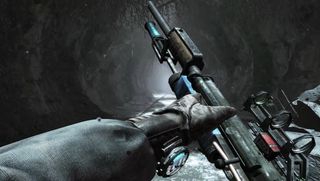
Returning is the customization system, which allows you to purchase weapons, upgrades, and equipment from vendors located in certain stations or tunnels, an immensely useful feature provided you can afford what's on offer.
Things like silencers can be bought and equipped to your guns, while filters and medpacks can be purchased to increase your survivability. Nearly every upgrade is a worthwhile one, but they're very expensive.
...but currency, ammo, and other resources are pretty scarce

As odd as it may seem, the reigning currency in the metro is military-grade ammunition. "Dirty ammo"--that is, bullets and slugs created in the tunnels from spent shells--is your primary ammo for shooting. Pick up a few rounds of pre-war bullets, though, and they're as good as gold. We only scrounged up enough of these during our two-hour session to buy one upgrade and a filter--if that's a representation of their scarcity, then you'll definitely want to choose your purchases wisely.
Regular ammo and items are rare finds, too--we ran low on ammunition a time or two during our demo, and relied on melee attacks whenever possible as to reserve our bullets for tougher opponents. The fact that you have to be smart about how you play is an incredibly refreshing element that few shooters in recent memory embraced. Get too trigger happy, and you're bound to end up in a bad spot.
The light at the end of the tunnel
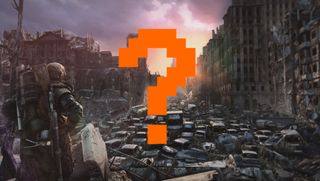
If you haven't yet gotten around to playing Metro 2033, we highly recommend doing so--especially because you can pick it up for ridiculously cheap. Are you looking forward to the sequel? If you have any questions about our hands-on time, drop us a note in the comments below and we'll do our best to respond.
And if you're looking for more info on upcoming games, check out everything we know about Assassin's Creed IV: Black Flag and 12 things you need to know about The Elder Scrolls Online .
Ryan was once the Executive Editor of GamesRadar, before moving into the world of games development. He worked as a Brand Manager at EA, and then at Bethesda Softworks, before moving to 2K. He briefly went back to EA and is now the Director of Global Marketing Strategy at 2K.
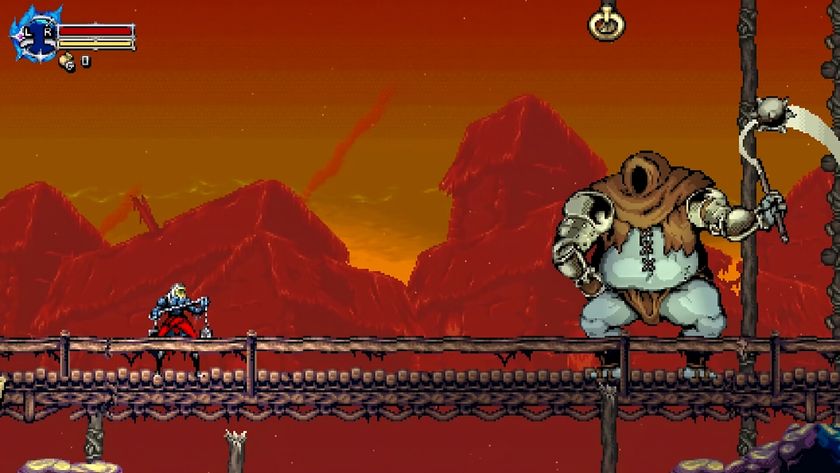
And you thought Hollow Knight: Silksong is late – 37 years in the making, this retro Metroidvania has a whip-smart Steam Next Fest demo that's as Castlevania as it gets
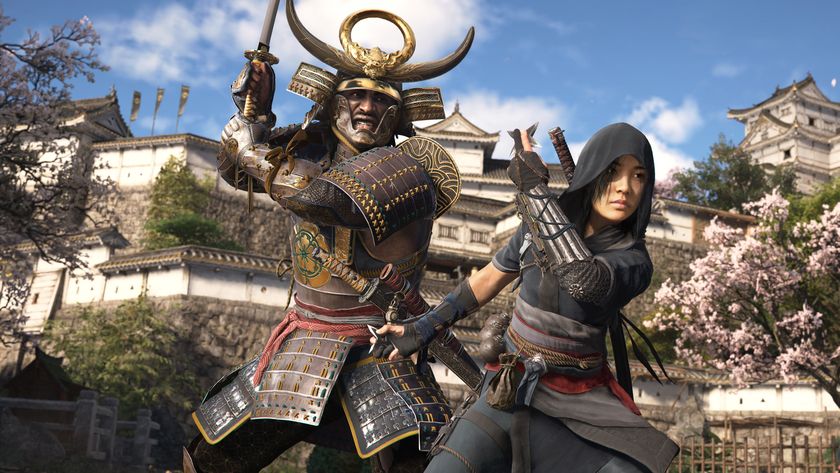
In Assassin's Creed Shadows, "Naoe and Yasuke share their progression" and you'll have to complete special quests to get the best abilities
Most Popular



